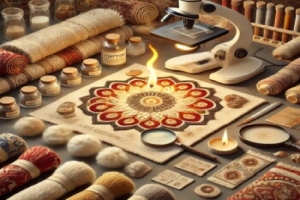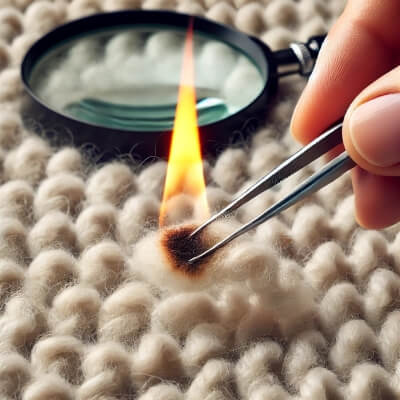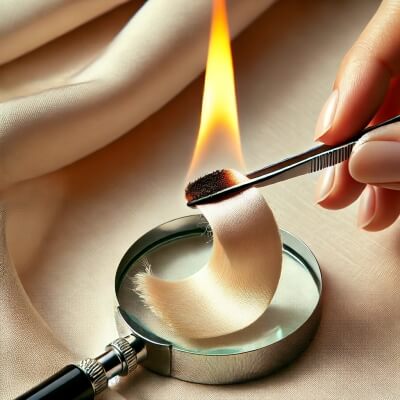How to recognise the material of oriental rugs? - Testing methods

When purchasing or appraising oriental rugs, one of the most important factors is determining the material composition. Natural materials such as wool, silk and cotton not only provide an excellent aesthetic and tactile experience, but are also outstanding for their durability and value retention. In the case of authentic hand-knotted oriental rugs, the quality of the material directly influences the lifespan and market value of the rug.
As there are many cheaper imitations available on the modern market, it is important to recognise the differences between the original and artificial materials. Some carpets are made from synthetic materials that may at first look similar to real wool or silk, but their properties and durability are very different.
The experts at CarpetDepo present practical tests that can help you easily determine whether an oriental rug is made of real wool, silk or cotton. These tests - such as the burn test, moisture test, touch test - offer a quick and effective way to verify the authenticity of materials, even in the home.
Let's see how to identify the real raw material of an oriental rug!
How do you recognise a cotton carpet?
Cotton carpets are popular for their natural softness, durability and ease of use. However, as there are many imitations made from synthetic materials on the market, it is important to recognise the original cotton carpet. Real cotton has excellent absorbency, it does not electrostatically charge and has a burn similar to paper.
The following tests - such as the burn test, moisture test, touch test and electrostatic test - will help you identify whether a carpet is made from real cotton or whether it contains synthetic materials.
Burn test🔥
The burn test is one of the most effective methods to determine whether a carpet is made of cotton.
Procedure:
Cut a small piece of the carpet (one strand is enough).
Use tweezers and, using a match or lighter, gently burn the end of the fibre.
Observe the way it burns and the ash produced.
Result:
The cotton burns quickly and gives off a paper-like smell.
The flame is yellowish and leaves a fine, easily disintegrating ash at the end.
If the material is synthetic, it melts, gives off a plastic smell and leaves a hard, lumpy residue.
Moisture test (water absorption)💦
Cotton is naturally absorbent, while synthetics absorb less water.
Method:
Drip a small amount of water onto the carpet.
Apply a little water to the carpet and see how quickly it absorbs moisture.
Result:
If the fabric absorbs water quickly, it is most likely cotton.
If the water rolls off or is absorbed slowly, it could be synthetic.
Rubbing test (electrostaticity)
Synthetic materials tend to be electrostatically charged, whereas cotton is not.
Procedure:
Rub the carpet together on a plastic surface or another fabric.
Observe whether the carpet attracts small pieces of paper or hairs.
Result:
Cotton does not produce a significant static charge.
Synthetic materials (e.g. polyester) are electrostatically charged and attract dust or small lint.
Microscopic examination 🔬
If you have a magnifying glass or microscope, you can observe the structure of the fibres.
Result:
The cotton fibres are irregular, slightly flattened and twisted.
Synthetic materials (e.g. polyester) have a smooth, even and shiny surface.

How do you recognise a wool rug?
Wool carpets have been a staple of oriental carpet making for centuries, thanks to their natural softness, flexibility and excellent thermal insulation properties. Real wool has a special structure that makes the carpet more durable and resistant, while providing a warm and comfortable feel.
However, as there are many synthetic imitations - such as polyester, acrylic or blended materials - it is important to be able to distinguish real wool from man-made materials. Wool smells like burnt hair when burned, has excellent absorbency and does not charge electrostatically, whereas man-made fibres behave differently.
The following tests - such as the burn test, moisture test, touch test and electrostatic test - will help you to determine exactly whether a carpet is made of real wool or contains synthetic materials.
Burn test🔥
Wool behaves in a typical way during the burn test.
Procedure:
Cut a small piece of yarn from the carpet.
Use a pair of tweezers to hold the fibre to the flame of a match or lighter.
Observe the way it burns, the smoke it produces and the residue.
Result:
The wool burns slowly and gives off the smell of burnt hair or feathers (because it is made of protein).
It goes out immediately after the flame is removed and does not continue to burn.
The ash is black, brittle and easily disintegrates.
If the material is synthetic, it melts and smells of plastic.
Wetness test💦
Wool has excellent moisture control properties as it can absorb large amounts of water without feeling wet.
Method:
Drip a small amount of water onto the carpet.
Observe how quickly the water is absorbed.
Result:
The wool absorbs water quickly, but the surface still feels dry.
Synthetic materials (e.g. polyester) repel water and do not absorb it easily.
Smell test (when wet)
Wool is a unique animal fibre, so when the carpet is wet it has a distinctive smell.
Procedure:
Wet the carpet with a little water.
Warm it up by hand or with a hairdryer.
Smell the carpet.
Result:
When wet, the wool carpet has a distinctive animal smell (similar to burnt hair or sheep hair).
Synthetic fabrics do not emit this smell.
Touch and elasticity test
Wool has a natural wavy texture, is supple and soft to the touch.
Method:
Fold the carpet, then unfold it again after a while.
Observe how quickly the carpet returns to its original shape.
Result:
The wool carpet quickly regains its shape because it is made of elastic fibres.
Synthetic or cotton carpets are less elastic and wrinkle more easily.
Electrostatic test
Wool is a natural material and therefore less prone to electrostatic charging than synthetic materials.
Method:
Rub the carpet together on a plastic surface or another fabric.
Observe whether it attracts dust or hairs.
Result:
The wool does not become electrostatically charged.
Synthetic materials (e.g. acrylic, polyester) can be highly charged and attract small lint.
Microscopic examination🔬
If you have access to a microscope or magnifying glass, wool fibres can be recognised by their characteristic wavy structure.
Result:
The wool fibres are uneven, wavy and have a scaly surface.
Synthetic fibres (e.g. polyester, acrylic) are smooth and straight.

How to recognise a silk carpet?
Silk rugs are among the most exclusive and precious pieces of oriental rug making. Natural silk is characterised by its exceptional lustre, softness and delicacy of touch, and is also incredibly strong and durable. Rugs made from original silk often feature detailed patterns and intricate knotting, making them even more precious.
However, there are many imitation silks (viscose, acetate) and synthetic silks on the market which may look similar in appearance, but are very different in durability and quality. The special refraction of real silk, its burnt hair-like smell when burned, and its natural thermal conductivity help to distinguish it from artificial alternatives.
The following tests - such as the reflectance test, burn test, tactile test and chemical test - help to determine exactly whether a rug is made of real silk or is a less valuable imitation.
Burn test 🔥
The burn test is one of the most reliable methods to identify genuine silk.
Procedure:
Cut a small piece of fibre or piece of material from the tested carpet.
Hold it in tweezers and touch it to a flame (e.g. a match or lighter).
Observe the way it burns, the smoke and the ash.
Result:
Real silk burns slowly and goes out immediately when removed from the flame.
It smells like burnt hair or feathers because it is made of protein (keratin).
The residue is a black, brittle ash that is easily crushed.
Synthetic silk melts and leaves a hard plastic ball.
The rayon (viscose) burns quickly and has a burnt paper smell.
Reflectivity test ✨
The reflection of the original silk rug is unique, which distinguishes it from artificial silk rugs.
Procedure:
Observe the fabric from different angles in natural or artificial light.
Result:
The original silk carpet has a deep and variable shine, with subtle colour changes when viewed from different angles.
Rugs made of artificial silk have a more uniform, intense sheen.
Rub test (heat test)🤲
Genuine silk is made of natural white and warms to the touch.
Method:
Gently rub a section of the carpet with two fingers for about 10-15 seconds.
Result:
That part of the original silk carpet warms up and creates a warm sensation on the skin.
The synthetic silk carpet stays cool because the synthetic fibres are a poorer conductor of heat.
Moisture test (water absorption) 💦
Real silk has excellent absorbency properties.
Procedure:
Drip a few drops of water on the carpet and observe the reaction.
Result:
Real silk carpet absorbs water quickly and dries in a short time.
Real silk carpet repels water and the drops roll off the surface.
Sound test (vibration test) 🎶
Silk has a special rustling or rustling sound that is not typical of other materials.
Procedure:
Take the carpet and gently rub it together.
Result:
The real silk carpet makes a fine, soft rustling sound, known as a "silk whisper".
A rayon carpet makes a dull or plastic-like sound.
Microscopic examination 🔬
If you have a magnifying glass or a microscope, the fibres of silk can be easily identified.
Result:
The fibres of the original silk carpet are gently wavy, uneven and slightly angular.
Synthetic silk carpet fibres are perfectly smooth and straight.
Tear test
Silk has a unique fibre structure and is therefore easily recognisable.
Procedure:
- Try to tear a small silk fibre by hand.
Result:
- Real silk is strong and does not tear easily.
- The rayon material is easier to tear.

Why is it important to test the material of oriental rugs?
Oriental rugs are not just decorative items, they are works of art of real value, often passed down through generations. The quality and authenticity of the material is a key factor in determining how durable, aesthetic and valuable a rug will be over the years. Real wool, silk and cotton rugs not only have a more pleasant feel and longer life, but also provide better ventilation and natural beauty.
With more and more synthetic or silk imitations appearing on the market, it is essential for discerning buyers to check the authenticity of the material. Tests such as burn tests, touch and reflectance tests, electrostatic tests help to distinguish genuine hand-knotted oriental rugs from cheaper alternatives.
By carrying out the right tests, we can ensure that we are buying a truly high quality and authentic oriental rug that will retain its beauty and value over time. Whether it's a traditional Persian, Afghan or other oriental rug, knowledge of the materials and the use of testing methods will help you make an informed decision and avoid disappointment.
If you are looking for a truly valuable oriental rug, take a look at our stock!
